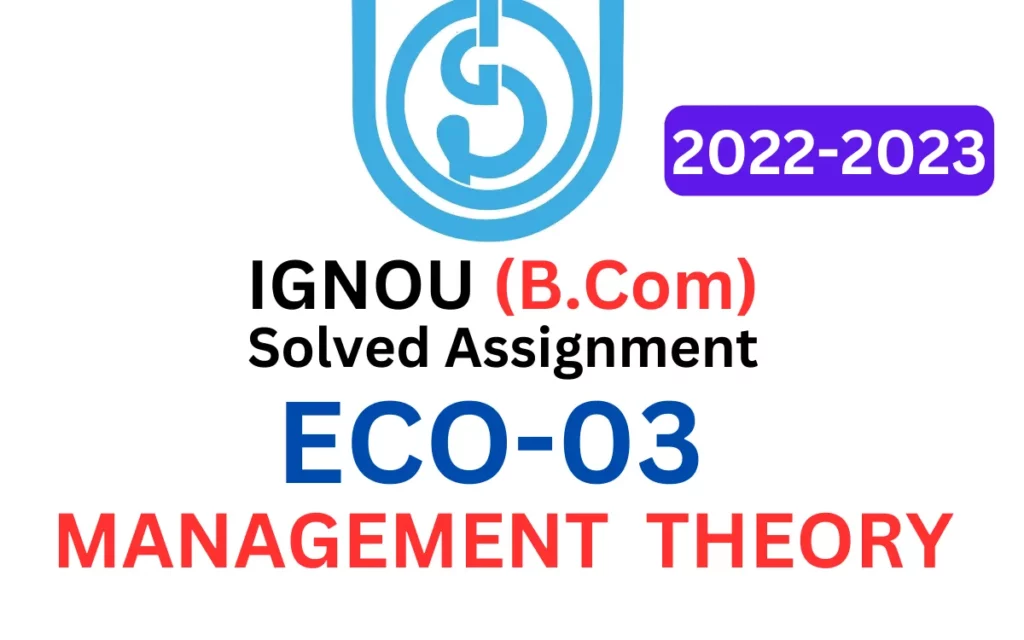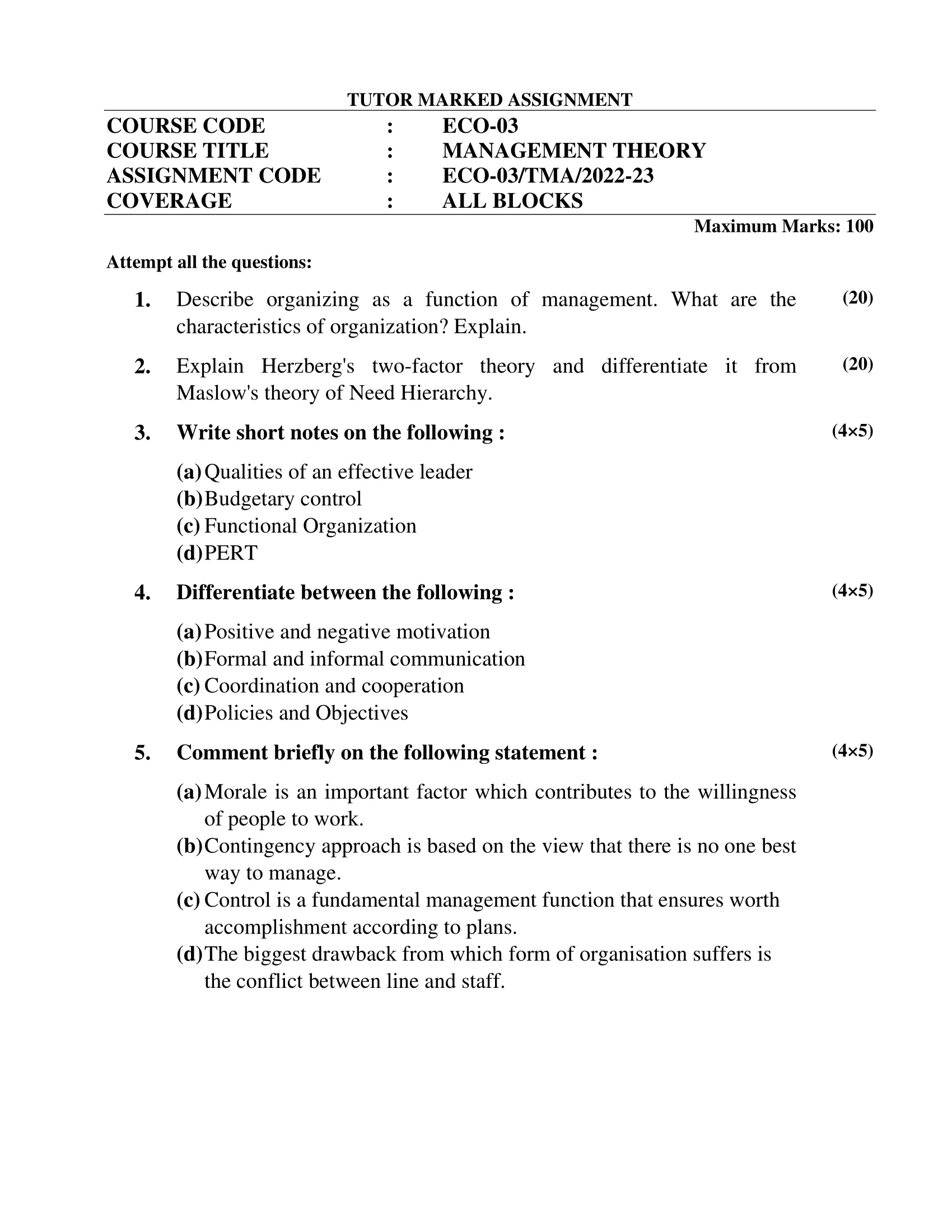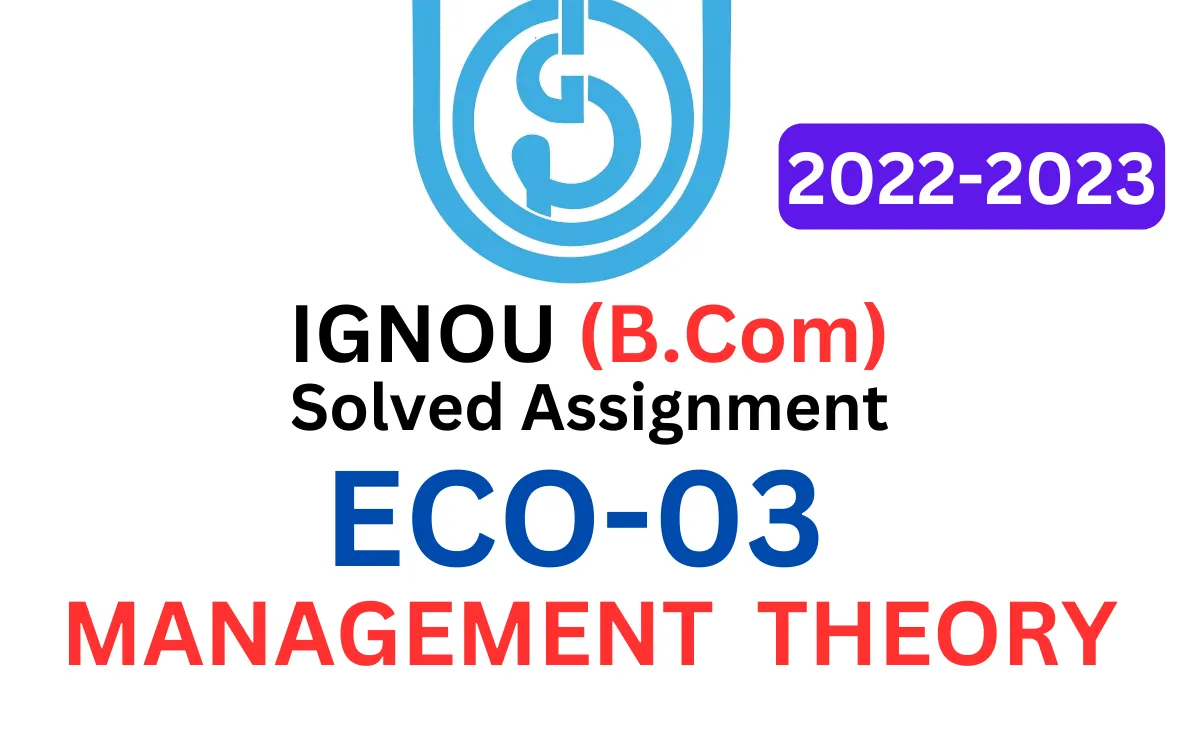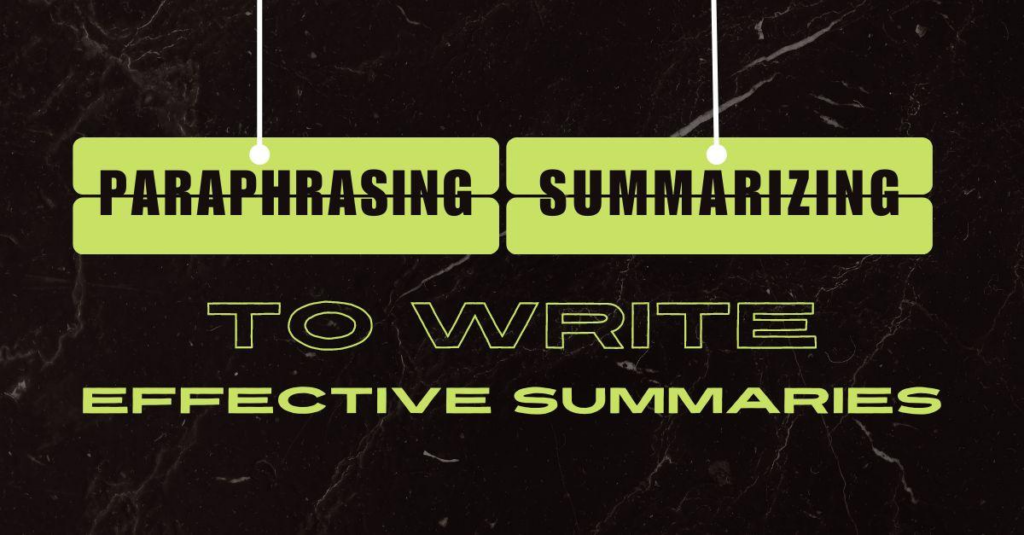
| Title | ECO-03: IGNOU B.Com Solved Assignment 2022-2023 |
| University | IGNOU |
| Degree | Bachelor Degree Programme |
| Course Code | ECO-03 |
| Course Name | Accountancy-1 |
| Programme Name | B.Com |
| Programme Code | BDP |
| Total Marks | 100 |
| Year | 2022-2023 |
| Language | English |
| Assignment Code | ECO-03/TMA/2022-23 |
| Assignment PDF | Click Here |
| Last Date for Submission of Assignment: | For June Examination: 31st April For December Examination: 30th September |

1. Describe organizing as a function of management. What are the characteristics of organization? Explain.
Ans: Organizing is one of the primary functions of management that involves arranging resources and tasks in a structured manner to achieve specific objectives. It involves determining the work that needs to be done, dividing it into manageable tasks, and assigning responsibilities to individuals or groups to achieve the desired outcome.
Characteristics of organization include:
- Structured approach: Organizing involves a structured approach to managing resources, tasks, and people. It aims to create a clear hierarchy of authority, roles, and responsibilities to ensure that work is completed efficiently and effectively.
- Coordination: It involves coordinating different activities to ensure that they work together harmoniously towards the desired goal. This involves ensuring that each department or team is aware of the goals and objectives of the organization, as well as their specific roles and responsibilities.
- Flexibility: Organizing also requires flexibility to adapt to changes in the external environment, such as shifts in customer needs or technological advancements.
- Clarity: Clear communication is essential in organizing to ensure that everyone understands their roles, responsibilities, and objectives. This helps to avoid confusion and ensures that everyone is working towards the same goal.
- Efficiency: The primary goal of organizing is to maximize efficiency and productivity by minimizing waste and reducing unnecessary duplication of effort.
2. Explain Herzberg’s two-factor theory and differentiate it from Maslow’s theory of Need Hierarchy.
Ans: Herzberg’s two-factor theory and Maslow’s theory of Need Hierarchy are both theories that attempt to explain human motivation in the workplace. However, they differ in their focus and approach.
Herzberg’s two-factor theory proposes that there are two types of factors that influence motivation and job satisfaction: hygiene factors and motivators. Hygiene factors are the basic job requirements such as salary, working conditions, company policies, and job security, and their absence can lead to dissatisfaction. Motivators, on the other hand, are factors such as recognition, achievement, responsibility, and personal growth, and their presence can lead to job satisfaction and motivation. Herzberg argues that improving hygiene factors does not necessarily lead to job satisfaction or motivation, but their absence can cause dissatisfaction. To motivate employees, organizations must focus on providing motivators such as recognition and opportunities for personal growth.
Maslow’s theory of Need Hierarchy proposes that human needs can be arranged in a hierarchical order, with basic physiological needs such as food and shelter at the bottom and self-actualization needs such as personal growth and fulfillment at the top. According to Maslow, individuals must satisfy their lower-level needs before they can be motivated by higher-level needs. Maslow’s theory suggests that individuals will be motivated to work towards fulfilling their needs, and this will drive their behavior and actions.
The main difference between the two theories is that Herzberg’s theory focuses on the specific factors that influence job satisfaction and motivation, while Maslow’s theory is a more general framework for understanding human motivation. Herzberg’s theory also emphasizes the importance of motivators such as recognition and personal growth, while Maslow’s theory places more emphasis on the hierarchical order of needs.
Write short notes on the following :
(a) Qualities of an effective leader
Ans: Qualities of an effective leader can include:
- Vision: An effective leader should have a clear vision of what they want to achieve and be able to communicate that vision to others.
- Integrity: Leaders need to be honest, trustworthy, and ethical in their dealings with others.
- Decisiveness: A leader needs to be able to make decisions quickly and effectively, taking into account the needs and perspectives of all stakeholders.
- Communication: Effective leaders should be able to communicate their ideas clearly and persuasively, and they should also be good listeners who take the time to understand the perspectives of others.
- Empathy: Leaders should be able to understand and connect with the emotions and experiences of their team members and stakeholders.
- Adaptability: Effective leaders should be able to adjust to changing circumstances and respond to unexpected challenges.
- Accountability: Leaders should be willing to take responsibility for their actions and decisions, and to hold themselves and others accountable for meeting goals and objectives.
- Confidence: A leader needs to have confidence in their own abilities and in the abilities of their team, while also being open to feedback and constructive criticism.
- Creativity: Effective leaders should be able to think creatively and innovatively, and to inspire their team members to do the same.
- Team–building: Leaders need to be able to build strong, cohesive teams that are motivated, engaged, and committed to achieving shared goals.
(b) Budgetary control
Ans: Budgetary control refers to the process of creating, implementing, and managing a budget for an organization or department. It involves setting financial goals, estimating revenues and expenses, and monitoring actual results against the budget to identify variances and take corrective actions.
The primary purpose of budgetary control is to ensure that an organization’s financial resources are effectively and efficiently used to achieve its goals. It allows managers to make informed decisions about resource allocation, prioritize spending, and identify areas where cost reductions or revenue enhancements are necessary.
To establish effective budgetary control, an organization typically follows the following steps:
- Establish budget objectives: Define the financial goals and objectives that the budget is intended to achieve.
- Develop a budget: Estimate revenues and expenses for the budget period, taking into account past performance, current trends, and future plans.
- Communicate the budget: Share the budget with relevant stakeholders and ensure that everyone understands their roles and responsibilities in meeting the budget targets.
- Monitor and control budget performance: Regularly monitor actual results against the budget, identify variances, and take corrective actions to keep the budget on track.
- Evaluate budget performance: Evaluate the effectiveness of the budget and the budgetary control process to identify areas for improvement and make necessary adjustments for future periods.
(c) Functional Organization
Ans: A functional organization is a type of organizational structure in which employees are grouped according to their functional areas, such as marketing, finance, operations, and human resources. Each functional area is headed by a manager who is responsible for overseeing the activities of the employees within that area.
In a functional organization, employees typically report to a manager within their functional area, rather than to a project or product manager. This structure allows for specialization within functional areas, which can lead to increased efficiency and productivity, as well as better communication and collaboration within each area.
Some of the key characteristics of a functional organization include:
- Clear hierarchy: There is a clear chain of command, with each functional area headed by a manager who reports to a higher-level executive.
- Specialization: Each functional area has specialized knowledge and skills that are applied to specific tasks or projects.
- Standardization: Processes and procedures are standardized within each functional area to ensure consistency and efficiency.
- Limited flexibility: Changes in the organization’s structure or processes may require significant coordination and planning.
- Silos: Departments can become isolated from each other, which can hinder communication and collaboration.
Functional organizations are commonly used in large, complex organizations, such as corporations or government agencies, where there is a need for specialized knowledge and expertise in different areas of the organization. While this structure can be efficient and effective, it may also have some drawbacks, such as limited flexibility and silos that can hinder cross-functional collaboration.
(d) PERT
Ans: PERT stands for Program Evaluation and Review Technique. It is a project management tool that helps to identify the critical path of a project and estimate the time needed to complete each task in the project.
The PERT technique is based on the use of a network diagram, which represents the sequence of activities in a project and the dependencies between them. Each activity is represented by a node on the diagram, and the dependencies between the activities are represented by arrows.
To use PERT, the following steps are typically followed:
- Identify the activities: Break down the project into a list of individual activities that need to be completed.
- Determine the sequence and dependencies: Determine the order in which the activities need to be completed and the dependencies between them.
- Estimate the duration: Estimate the time required to complete each activity, including the best-case scenario, the worst-case scenario, and the most likely scenario.
- Create the network diagram: Use the information gathered in steps 1-3 to create a network diagram.
- Identify the critical path: Identify the longest sequence of activities that must be completed in order to finish the project on time.
- Monitor and control: Monitor the progress of the project and make any necessary adjustments to ensure that it stays on schedule.
Differentiate between the following :
(a) Positive and negative motivation
Ans: Positive and negative motivation are two different approaches to motivating people to achieve their goals. The main difference between them is the type of incentives or consequences that are used to encourage behavior.
Positive motivation is based on the use of positive incentives to encourage behavior. Positive incentives can be rewards, recognition, praise, or any other type of positive feedback that reinforces the desired behavior. For example, a manager might offer a bonus or promotion to an employee who meets or exceeds their sales targets, or a teacher might give a student a sticker or certificate for doing well on a test.
Negative motivation, on the other hand, is based on the use of negative consequences or punishments to discourage behavior. Negative consequences can be anything from a reprimand or loss of privileges to more severe punishments like fines or imprisonment. For example, a supervisor might threaten to demote or fire an employee who consistently misses deadlines or makes mistakes, or a parent might ground a child for failing to complete their chores.
In general, positive motivation is seen as more effective and desirable than negative motivation. Positive motivation is associated with increased engagement, productivity, and job satisfaction, while negative motivation can lead to fear, stress, and resentment. However, there may be situations where negative motivation is necessary to correct or prevent undesirable behavior, such as in cases of safety violations or unethical conduct.
(b) Formal and informal communication
Ans: Formal and informal communication are two different types of communication that occur within organizations.
Formal communication refers to official communication that takes place within a structured and predefined communication channel, such as an email, memo, report, or meeting. It is typically planned, deliberate, and documented. Formal communication is usually used to convey official information, such as policies, procedures, announcements, and performance feedback. The language used in formal communication is often more formal and professional, and the tone is typically serious and respectful.
Informal communication, on the other hand, refers to unofficial communication that takes place outside of formal channels. It is typically unplanned, spontaneous, and unstructured. Informal communication can take many forms, such as water cooler conversations, impromptu meetings, or casual emails. It is often used to build relationships, exchange personal information, and discuss topics that are not related to work. The language used in informal communication is often more relaxed and informal, and the tone is usually friendly and conversational.
(c) Coordination and cooperation
Ans: Coordination and cooperation are two different concepts that are important in achieving organizational goals.
Coordination refers to the process of ensuring that different tasks, activities, and functions are properly aligned and integrated towards a common goal. It involves establishing a clear vision, defining roles and responsibilities, setting priorities, and synchronizing activities. Coordination is necessary for ensuring that resources are used efficiently, avoiding duplication of efforts, and ensuring that all parts of an organization are working towards the same objective.
Cooperation, on the other hand, refers to the willingness of individuals or groups to work together towards a common goal. It involves sharing information, resources, and expertise, and supporting each other in achieving their objectives. Cooperation is important for building relationships, fostering trust, and creating a positive work environment.
While coordination and cooperation are related concepts, they differ in terms of their focus and scope. Coordination is focused on aligning tasks and activities, while cooperation is focused on building relationships and promoting a positive work environment. Effective coordination requires cooperation among team members, while cooperation is enhanced by effective coordination.
Both coordination and cooperation are important for achieving organizational goals. A balance between the two is necessary for effective teamwork and collaboration within an organization.
(d) Policies and Objectives
Ans: Policies and objectives are both important components of organizational planning and management, but they differ in their scope and level of specificity.
Policies are broad guidelines or principles that help guide decision-making and behavior within an organization. Policies are usually developed at the highest levels of an organization, such as by the board of directors or executive leadership team, and provide a framework for lower-level decision-making. Policies are generally fairly stable over time and may be reviewed periodically to ensure that they remain relevant and effective.
Objectives, on the other hand, are specific, measurable targets that are set by an organization to guide its activities and measure progress towards achieving its goals. Objectives are typically more specific and detailed than policies, and are often developed at lower levels of the organization, such as by department managers or project teams. Objectives may be short-term or long-term, and may be adjusted or revised as circumstances change.
Comment briefly on the following statement :
(a) Morale is an important factor which contributes to the willingness of people to work.
Ans: The statement “Morale is an important factor which contributes to the willingness of people to work” is generally true. Morale refers to the overall sense of satisfaction, motivation, and enthusiasm that employees feel towards their work, colleagues, and the organization they work for. When employees have high morale, they tend to be more engaged, productive, and committed to their work, which can lead to better outcomes for the organization.
On the other hand, low morale can lead to decreased motivation, increased absenteeism, and even turnover, which can be costly for organizations. Therefore, it is important for managers to understand the factors that influence employee morale, such as fair treatment, recognition, and opportunities for personal growth, and take steps to maintain a positive work environment that fosters high morale.
(b) Contingency approach is based on the view that there is no one best way to manage.
Ans: The statement “Contingency approach is based on the view that there is no one best way to manage” is generally true. The contingency approach to management recognizes that there is no one-size-fits-all approach to managing people and organizations, and that the most effective management approach depends on the unique circumstances of each situation.
The contingency approach is based on the idea that there are many different variables that can influence management decisions, such as the organization’s size, structure, culture, technology, and environment. Therefore, the most effective management approach will vary depending on these variables, and managers must be able to adapt their approach to fit the specific situation.
For example, a management style that works well in a small, informal startup may not be effective in a large, bureaucratic organization. Similarly, a management approach that is successful in one industry may not work as well in another industry due to differences in technology, customer needs, or regulatory requirements.
The contingency approach also emphasizes the importance of flexibility and responsiveness in management, as managers must be able to adapt their approach as circumstances change. This requires managers to have a deep understanding of the organization and its environment, as well as strong problem-solving skills and the ability to make effective decisions.
(c) Control is a fundamental management function that ensures worth accomplishment according to plans.
Ans: The statement “Control is a fundamental management function that ensures worth accomplishment according to plans” is generally true. Control is one of the primary functions of management, along with planning, organizing, and leading, and it involves monitoring and evaluating performance to ensure that goals and objectives are being met.
Control helps managers ensure that resources are being used efficiently and effectively, and that progress is being made towards achieving the organization’s goals. This can involve setting performance standards, measuring performance, comparing actual performance to the standards, identifying deviations, and taking corrective action when necessary.
In order to control effectively, managers must have access to accurate and timely information, and be able to analyze and interpret that information to make informed decisions. They must also be able to communicate performance expectations clearly to employees, and provide feedback on their performance.
Effective control requires a balance between maintaining appropriate levels of oversight and allowing employees to have some autonomy in their work. Managers must also be able to adapt their control measures as circumstances change, such as changes in the external environment or shifts in the organization’s goals.
(d) The biggest drawback from which form of organisation suffers is the conflict between line and staff.
Ans: The statement “The biggest drawback from which form of organization suffers is the conflict between line and staff” is a matter of debate and may not necessarily be true for all forms of organization.
In certain forms of organization, such as the traditional hierarchical structure, line and staff functions may be clearly defined and separated, with line functions responsible for producing goods or services, while staff functions provide support and guidance to the line functions. In this case, conflict between line and staff may arise if there is a lack of clarity or communication about roles and responsibilities, or if there is a perceived lack of value or appreciation for the contributions of staff functions.
However, in other forms of organization, such as matrix organizations or cross-functional teams, the lines between line and staff functions may be less clear, with employees working collaboratively across multiple functions and departments. In these cases, conflict may arise due to differences in goals, priorities, or perspectives between different groups or individuals, rather than simply between line and staff.
How to Download ECO-03 Solved Assignment?
You can download it from the www.edukar.in, they have a big database for all the IGNOU solved assignments.
Is the ECO-03 Solved Assignment Free?
Yes this is absolutely free to download the solved assignment from www.edukar.in
What is the last submission date for ECO-03 Solved Assignment?
For June Examination: 31st April, For December Examination: 30th October




